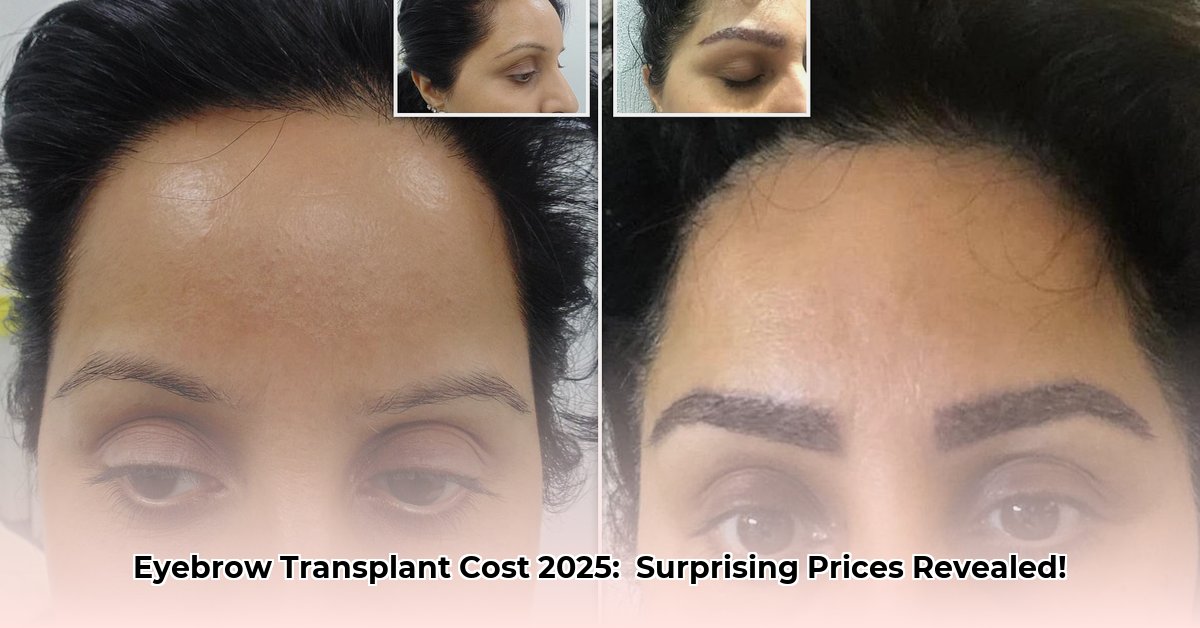Thinking about getting your eyebrows enhanced with a transplant? It’s a popular procedure, but costs can vary greatly. This guide breaks down everything you need to know about budgeting for the process, from surgical techniques to clinic locations. We’ll explore different methods, explain the factors influencing price, and provide guidance on finding a qualified doctor. We’ll also cover what to expect during and after the procedure, potential risks, and financing options, giving you the information needed to make an informed decision about eyebrow restoration. Note that insurance coverage for such procedures can vary; check out insurance coverage for details.
Understanding Eyebrow Transplant Costs: Key Factors and Pricing
Thinking about eyebrow restoration? Procedures have become increasingly popular, offering a solution for thin or uneven eyebrows. But before you commit, it’s important to discuss costs, because this can fluctuate considerably. This guide helps you understand the variables affecting price and how to make informed decisions for your budget and desired results.
Decoding the Variables: Understanding Cost Drivers for Eyebrow Transplants
Several elements affect the ultimate price, and they all combine to assess the final cost. Let’s break them down:
1. The Transplant Technique (FUT vs. FUE): There are two main approaches: Follicular Unit Transplantation (FUT) and Follicular Unit Extraction (FUE). FUT involves removing a strip of scalp skin with hair follicles, often resulting in a linear scar. FUE extracts individual hair follicles directly from the scalp, leaving behind minuscule, less noticeable scars. FUE generally results in less visible scarring but can be more time-consuming and therefore more expensive. The decision depends on individual preferences, the surgeon’s recommendations, and balancing cost with desired scarring outcomes.
2. The Number of Grafts Needed: This is a primary cost driver. The more hair follicles that need to be transplanted, the higher the cost. Fuller, more dramatic brows require more grafts, leading to a higher investment. The number of grafts needed can vary widely depending on the individual’s existing brow density, desired fullness, and the size and shape of the eyebrows they wish to achieve. Your surgeon will assess your brows and determine the required number of grafts for your goals.
3. Surgeon’s Expertise and Reputation: A skilled, experienced, and board-certified surgeon will likely charge more than someone less established. While the upfront cost may be higher, the investment can be justified by greater precision, skill in artistic brow design, lower complication rates, and ultimately, better, more natural-looking results. A surgeon with extensive experience in eyebrow transplants will be better equipped to handle the nuances of hair placement and angle, leading to a more aesthetically pleasing outcome.
4. Geographic Location: Does Location Impact Eyebrow Transplant Costs?: Location significantly impacts the price. Procedures in major metropolitan cities or areas with a high cost of living tend to be more expensive due to higher overhead costs for clinics and surgeons. Conversely, procedures in smaller towns or countries with lower healthcare costs can be more affordable. International options exist, such as in Turkey and Thailand, which are known for more affordable cosmetic procedures; however, these options may carry additional risks due to potentially different regulatory standards, language barriers, and the difficulty in securing follow-up care should complications arise.
5. Pricing Models (per graft vs. flat fee): Some surgeons charge per graft transplanted, offering a transparent pricing structure where you pay for each individual follicle moved. Others might offer a flat fee for the entire procedure, regardless of the precise number of grafts used. A per-graft model can provide more cost control for smaller enhancements, while a flat fee offers more cost certainty for extensive reconstructions. It’s important to understand what the flat fee includes (e.g., facility fees, anesthesia costs, post-operative care) and whether there are any potential additional charges. Discuss both options thoroughly with your prospective surgeon to determine the most cost-effective and predictable approach.
Decoding the Numbers: Average Eyebrow Transplant Costs and Price Ranges
Data indicates that the average cost of an eyebrow transplant in 2025 ranges from $4,000 to $10,000. Depending on the factors discussed, the actual cost can fall above or below this range. Here’s a closer look at cost breakdowns based on aggregated data, recognizing this is a general guide:
| Cost Range | Description |
|---|---|
| $3,000 – $5,000 | Typically covers less extensive procedures, potentially in smaller cities or with less experienced surgeons. May involve FUT technique. |
| $5,000 – $8,000 | More common range for standard procedures with experienced surgeons in average-cost areas, possibly using FUE. |
| $8,000 – $11,000 | Procedures in high-cost areas with highly experienced surgeons, often utilizing advanced FUE techniques. |
| $11,000 – $14,000+ | Complex reconstructions, celebrity surgeons in prime locations, or procedures requiring a very high number of grafts. |
Remember, these ranges are estimates and can vary significantly. Always obtain a personalized quote from a qualified surgeon after a thorough consultation.
Finding a Provider: A Key Step in Eyebrow Restoration
Choosing a qualified and experienced surgeon is essential. Don’t let cost alone drive your decision. Check credentials, verify board certification in a relevant field (plastic surgery, dermatology, facial plastic surgery), read online reviews (but consider them critically and look for patterns), and schedule consultations with several surgeons. Ask detailed questions about their experience with eyebrow transplants, the techniques they use, their approach to brow design, and potential complications. Request to see before-and-after photos of their previous eyebrow transplant patients to assess their aesthetic skill. This comprehensive consultation process will allow you to compare their approaches, pricing structures, and communication styles, leading to an informed decision.
Navigating the Procedure: Step-by-Step
The procedure usually involves these phases:
- Initial Consultation: Discuss your aesthetic goals, medical history, and any questions or concerns. The surgeon examines your eyebrows and scalp, assesses hair quality and availability, and determines the feasibility of a transplant, along with the estimated number of grafts you’ll likely need. They should also provide a realistic expectation of the results.
- Pre-operative Preparations: Your surgeon will provide detailed pre-operative instructions, which may include recommendations for diet, restrictions on certain medications and supplements (e.g., blood thinners), and guidelines on pre-operative hygiene. Closely following these instructions is crucial for minimizing risks and ensuring optimal healing.
- The Procedure: Eyebrow transplant procedures are typically performed on an outpatient basis under local anesthesia with or without sedation. The surgeon carefully extracts hair follicles (FUE) or a strip of scalp tissue (FUT) before meticulously placing individual grafts into the pre-designed eyebrow area, paying close attention to the angle and direction of hair growth. The procedure can take several hours, depending on the complexity of the case.
- Post-operative Care: Post-operative care is essential for successful healing and optimal results. You’ll receive specific instructions from your surgeon regarding wound care, medication (e.g., antibiotics to prevent infection, pain relievers), activity restrictions (e.g., avoiding strenuous exercise and sun exposure), and follow-up appointments. Adhering to these instructions is vital to minimize the risk of complications and promote graft survival.
Understanding Risks and Potential Complications
While generally safe when performed by a qualified surgeon, like all surgical procedures, eyebrow transplants carry potential risks. Potential complications include infection, bleeding, scarring (particularly with FUT), uneven hair growth, temporary swelling and bruising, numbness, ingrown hairs, and graft failure (i.e., some transplanted hairs not taking root). In rare cases, patients may experience nerve damage or an allergic reaction to anesthesia. A thorough and frank discussion about these risks with your surgeon is essential before proceeding.
Financing Your Procedure: Exploring Options
Eyebrow transplants are generally considered cosmetic procedures and are typically not covered by health insurance. Given the potentially substantial cost, financing may be needed. Many surgeons offer financing plans directly through their clinics, while you can also explore third-party options like medical credit cards (e.g., CareCredit, Alphaeon Credit), personal loans from banks or credit unions, or even crowdfunding. Carefully compare interest rates, repayment terms, and eligibility requirements before making a decision.
Maintaining Your Investment: Long-Term Results and Maintenance
With proper aftercare and healing, the results of an eyebrow transplant are usually long-lasting. The transplanted hair follicles should continue to grow naturally in the eyebrow area. However, because the transplanted hairs originate from the scalp, they may grow at a faster rate and require more frequent trimming than your original eyebrow hairs. Occasional shaping and grooming may also be necessary to maintain the desired eyebrow thickness and shape. Some patients may also benefit from touch-up procedures over time to address any thinning or asymmetry that may develop.
Making an Informed Decision: A Measured Approach
Undergoing an eyebrow transplant is a significant decision that requires careful consideration of your aesthetic goals, budget, and the potential risks and benefits of the procedure. Thorough research, multiple consultations with qualified surgeons, realistic expectations, and a clear understanding of the costs involved are all essential for a satisfying outcome. Prioritize finding a board-certified surgeon with extensive experience in eyebrow transplantation and a strong aesthetic sense.
Selection Tactics: Choosing the Perfect Eyebrow Transplant Clinic to Optimize Results
- Eyebrow transplants offer a permanent solution for thinning or lost eyebrow hairs, but success hinges on finding an experienced doctor and maintaining realistic expectations.
- Costs can range widely based on technique and graft number.
- Bento Box Trays Streamline Restaurant Meal Presentation and Transport - December 13, 2025
- Plastic Bento Boxes Face Scrutiny Over Sustainability Impacts - December 11, 2025
- Bento Tray Revolutionizes Organized Meal Transport and Presentation - December 10, 2025










